Explore The Rich Heritage Of Maharashtra At Sangam Mahuli In 2025
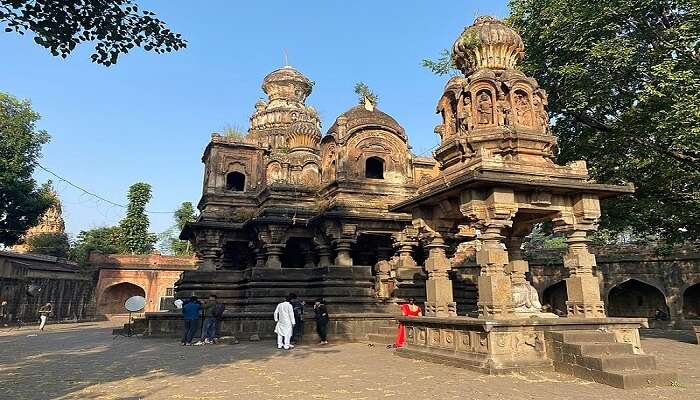
Sangam Mahuli is located at the confluence of the Venna and the Krishna rivers in the Satara district of Maharashtra. Sangam translates to Confluence. At a distance of 5 km from Satara Bus Station, Sangam Mahuli is a heavily visited pilgrimage destination in Satara. It is renowned for the 18th and 19th-century temples that exude a majestic Maratha style of architecture. Sangam Mahuli is a go-to place for heritage and architecture enthusiasts. But, travellers are advised to be careful when visiting the village during the monsoon season. The rivers often tend to flood and the entire area can be prohibited.
About The Sangam Mahuli
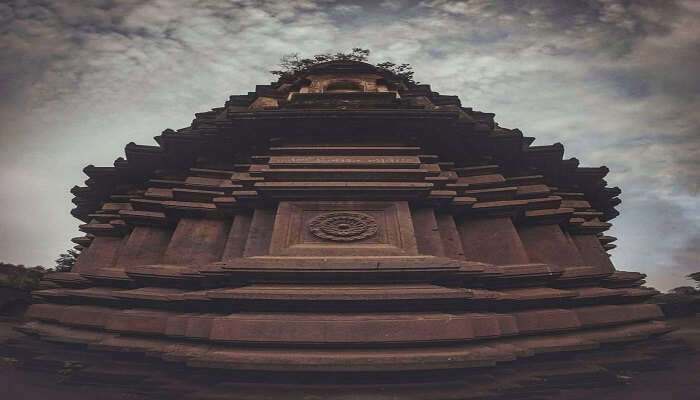
Apart from the mystique of spirituality and its prominence as a pilgrimage destination, Mahuli is also well remembered for its historical anecdotes. It is believed that the relevance of this land has its origin in the Treta Yuga, as the history of Mahuli dates back to the Ramayana. If you ask the local devotees, they will point to a huge tree near the Rameshwar Temple, where it is believed that Lord Rama had halted (under the tree) during his exile.
Another local belief about the history of this pilgrimage destination is that once, Chhatrapati Shahu Maharaj was on a visit to Mahuli for some religious work. But he could not find any priest (or Brahman) to perform the spiritual activity. So, stepping up to the occasion, Shri Patrao Pant, accompanying Chhatrapati Shahu Maharaj, performed the rituals for him. In return, Shahu Maharaj gave him a huge piece of land. That piece of land is where Shri Patrao Pant laid the foundation of Mahuli, and we see the present-day Sangam Mahuli. It was also the birthplace of Ramshastri Prabhune, the esteemed spiritual and political advisor of the fourth Peshva Madhavrav. Moreover, Mahuli witnessed pivotal moments in history, the most widely remembered being the meeting between the last Peshwa Bajirav and Sir John Malcolm preceding the Anglo-Maratha war. All these historical events reveal Mahauli’s significance.
Must Read: Places To Visit In Satara
Architecture Of Sangam Mahuliu
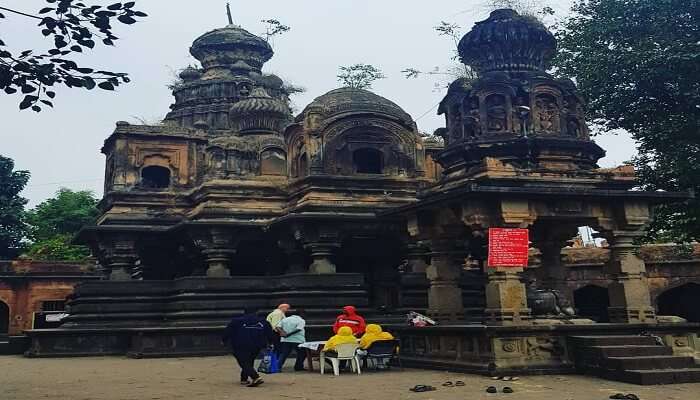
Being a popular pilgrimage destination in Satara, Sangam Mahuli boasts rich historical significance and a plethora of architectural marvels. The two famous temples located at this spot of the confluence of the Krishna river and its tributary are the Vishveshwar Temple and the Rameshwar Temple. Sri Kashi Vishweshwar temple lies at the absolute heart of the region. Built in 1735 CE by Shripatrao Pant Pratinidhi, the temple is dedicated to Lord Shiva. The exquisite Hmedapanth-style architecture tells about the region’s flair and artistic prowess.
And, just when you look up to the opposite bank of the Krishan River, you enter the beautiful village of Kshetra Mahuli. This village allows visitors to enter a world of spirituality and tranquillity. Here lies the beautiful Rameshwar temple that is dedicated to Lord Shiva. The temple has a Nagara-style shikhara with a mesmerising Shivlingam surrounded by the calm and pristine water of the Krishna river.
Places To Visit Near Sangam Mahuli
When a pilgrimage destination originates in the times of Ramayana and holds significance in modern history, you should definitely plan on visiting such a location. Sangam Mahuli offers many more places that you can visit to explore the tranquillity of this place.
1. Vishweshwar Temple
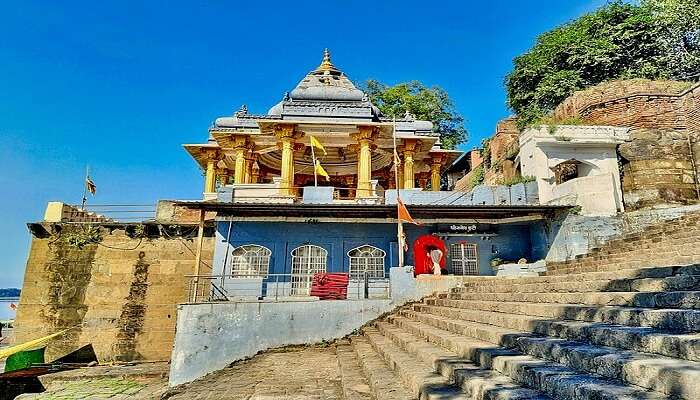
It is strongly believed for this temple to have been built by Shripatrao Pant Pratinidhi back in 1735 CE. This land was bestowed by Shahu Maharaj upon Shripatrao Pant Pratinidhi as a Brahman Dakshina. Pant Pratinidhi, in turn, donated the land to another Brahmin, Anant Bhat Galande.
Vishweshwar Temple was constructed and built in typical Maratha features of the Hemadpanth style of architecture on the banks of River Krishna. The temple boasts a sabha mandap and an antarala as well as a garbhagriha. The temple structure measures a staggering 50 feet in length and 20 feet in breadth built with basalt stone. The presiding deity Lord Shiva appeared as a lingam in the sanctum sanctorum. The sculptures and idols inside the garbhagriha are exquisite and very neatly and finely carved. The temple walls are beautifully adorned with intricately carved sculptures while the walls leading up to the sanctum sanctorum, display idols of both Goddess Parvati and Lord Ganesha. Another major architectural marvel of the Vishweshwar Temple is the mammoth 60-foot tall lamp-post that is carved out of a single block of stone in a genius manner. The post has thoughtfully carved provisions to place oil lamps. At the entrance of this temple, the devotees can vividly spot a Nandi Temple. The Nandi Temple has an exquisitely carved dome and is frequented by the devotees who come to visit the Vishweshwar Temple.
Best Time To Visit: October To February
Distance From Sangam Mahuli: 7.4 Km
Suggested Read: Things To Do In Alibaug
2. Rameshwar Temple

This temple is also dedicated to Lord Shiva but is quite small compared to the Vishweshwar Temple.
Rameshwar temple is right opposite the towering Vishweshwar Temple on the other side of Krishna River at Kshetra Mahuli. The temple premises have an elegant nagara-style shikhara built with only bricks and lime. Here the main Shivlingam is splendid and surrounded by the confluence water. The visiting devotees must cross the Krishna River bridge to reach the Rameshwar Temple. The sabha mandap here houses the idols of Lord Ganesha and Parvati. Also situated in the same complex is a Nandi mandap with a very elaborately decorated Nandi idol. There is also a tall stone deepasthambha that adds up to the magnificence of the complex.
Best Time To Visit: October To February
Distance From Sangam Mahuli: 3.0 Km
Best Time to Visit Sangam Mahuli
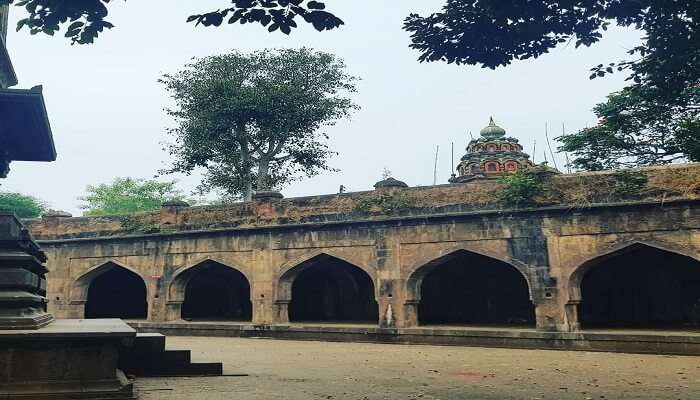
Any season except the monsoon is deemed desirable and recommended to visit Sangam Mahuli. Travellers planning to visit this village during the rainy season are advised to take great caution. The rivers often tend to overflow and visiting these villages may be prohibited during some days. However, you can get a glimpse of these rivers from the flyover on the Satara – Koregaon road. An exploration of this village, its marvellous temple complexes on both banks of the river and the ever-illustrious history of Satara city will not take more than 2 hours of your time.
Further Read: Picnic Spots In Maharashtra
Now you have complete information about Sangam Mahuli and the surrounding places of interest, which gives you a list of reasons to visit this village in Satara. Make sure you plan your trip to Maharashtra as soon as possible and don’t forget to explore this city’s historical and architectural marvels. Don’t miss exploring this fantastic location and book your tickets now!
For our editorial codes of conduct and copyright disclaimer, please click here.
Cover Image Credit: Vinayaraj for Wikimedia Commons
Frequently Asked Questions About Sangam Mahuli
Who donated the land for this temple?
This temple is believed to have been built by Shripatrao Pant Pratinidhi back in 1735 CE. This land was bestowed by Shahu Maharaj to Shripatrao Pant Pratinidhi, as a mark of respect during a Brahman Dakshina. Pant Pratinidhi, in turn, gave away this land to another Brahmin, Anant Bhat Galande.
Who was Ramshastri Prabhune?
Ram Shastri Prabhune was the Chief Justice or Mukhya Nyayadhish or Pantnyayadhish (as known in those times) in the apex court of the Maratha Empire in the latter half of the 18th century, during the heyday of the illustrious empire. History remembers him for having passed strictures against the sitting Peshwa of the time for instigating murder. Ram Shastri's integrity in public affairs is hailed as a model for all times.
How to reach Sangam Mahuli?
Sangam Mahuli is located at a distance of 5 km from the Satara Bus Station. This village is based at the confluence of the Venna and Krishna Rivers, with another beautiful village called Kshetra Mahuli based on the opposite river bank. You can choose to either hire an auto or a private taxi from the bus station to reach Sangam Mahuli comfortably. Or alternatively, you can reach the village on a two-wheeler/ bike as well.
Is Kaas Plateau worth visiting?
Kaas plateau is a plateau located near Satara. It is situated among the high hill plateaus and the grasslands turn into a 'valley of flowers' during monsoon season, particularly between the months of August to early October. Kaas Plateau has more than 150 or more identified types of flowers, shrubs and grasses. The orchids bloom here for at least 3–4 weeks during this season. Kaas plateau has been recognised as a World Natural Heritage site, part of the Sahyadri Sub-cluster.
Which waterfall is located in Satara?
The stunning Thoseghar Falls is located near the village of Thoseghar at a distance of 20 km from the city of Satara in Maharashtra. The Thoseghar Falls are a series of breathtaking waterfalls with some falls as high as 15-20m, whereas, the highest fall plummeting from a picturesque height of 200m. The calm and peaceful scenery, and surrounding landscapes accompanied by the thunderous sound of the gushing water are the main attractions of the Thoseghar Falls.
People Also Read:
Places To Visit In Maharastra In Summer Best Hill Stations In Maharastra Camping Near Mumbai

With a passion for exploring and travelling to the roads long forgotten, experience the world through enthralling stories and adventures. Join me as I share my experiences at some of the world’s most popular tourist destinations and quench that pestering curiosity with something exciting!











